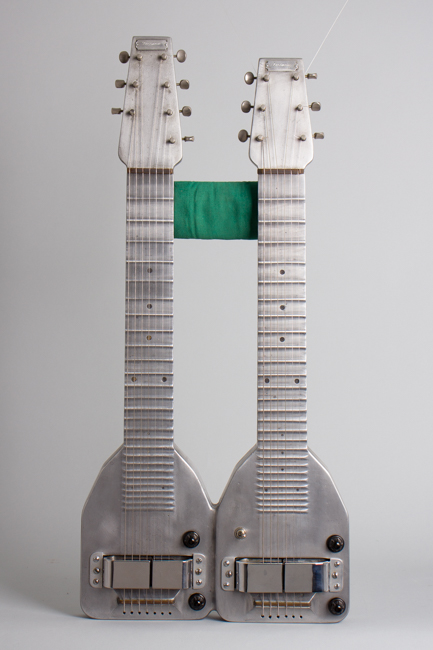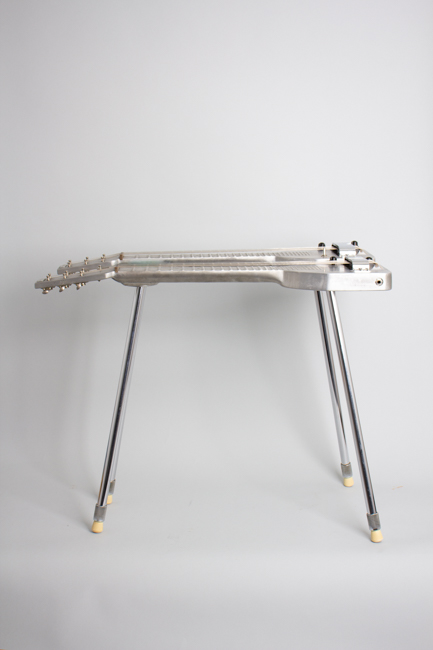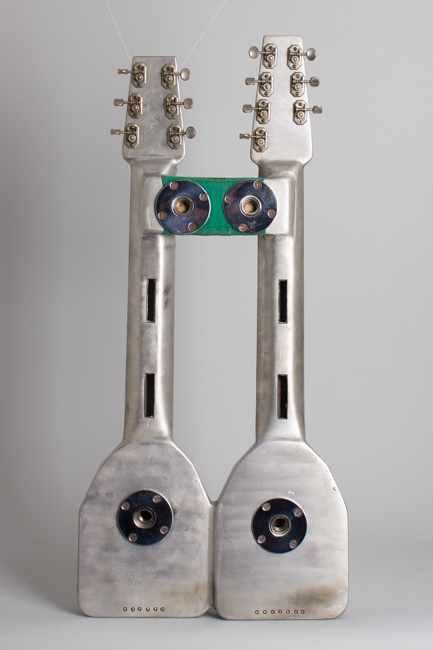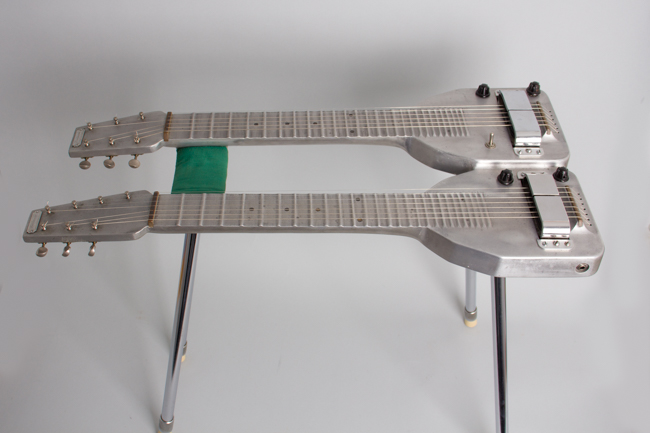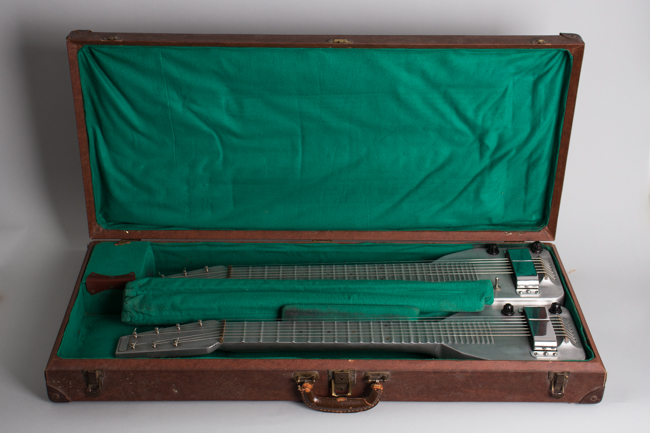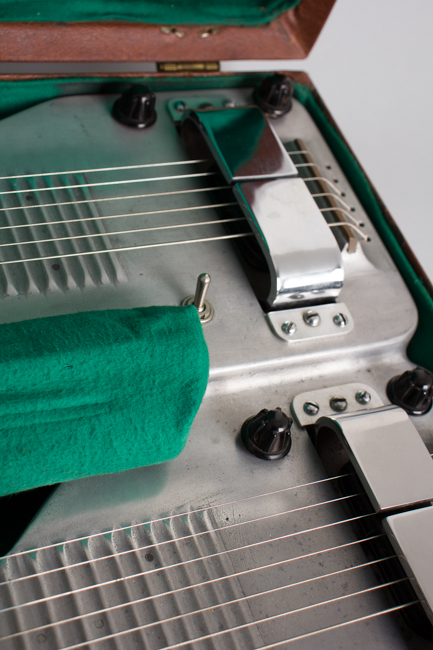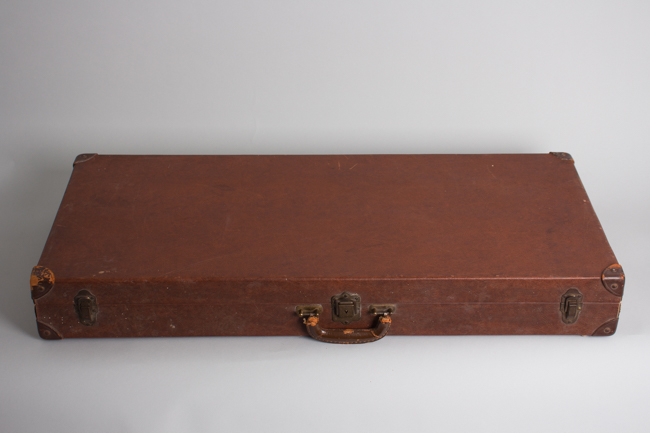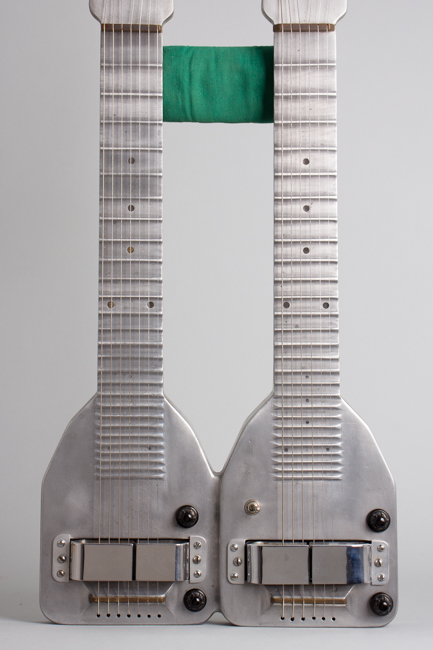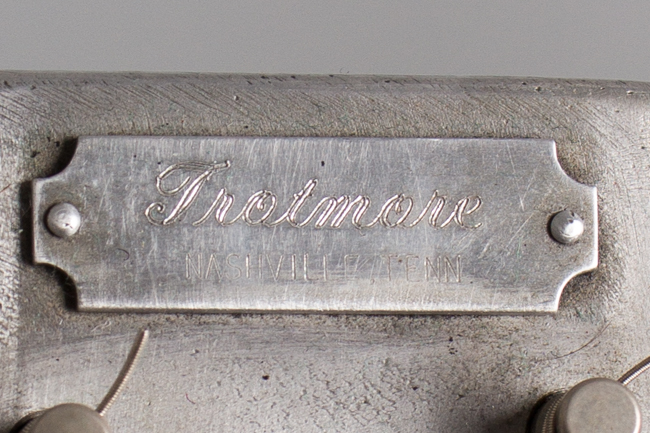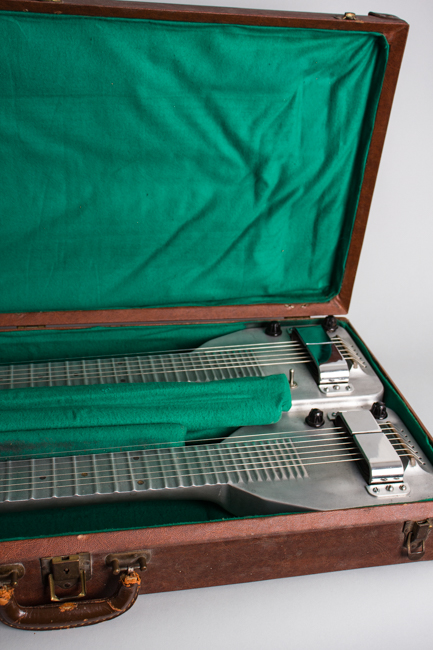Trotmore Doubleneck High Steel Electric Guitar , c. 1953
This item is currently on hold.
Item # 12027
Prices subject to change without notice.
Trotmore Doubleneck Model High Steel Electric Guitar, c. 1953, made in Nashville, TN, silver paint finish, cast aluminum body, original brown hard shell case.
This is a really unique and exceptionally rare piece, a doubleneck Rickenbacker-style cast aluminum high steel built in the early 1950s by a short-lived, poorly documented Nashville operation called Trotmore. The look is very late-deco rocket ship; this would not feel out of place in a Flash Gordon film! The instrument was built by Ira Trotter and his partner Grady More around 1953-4; the idea was to create a steel equal to Rickenbacker's pre-war aluminum models. Steel legend Jerry Byrd was involved, and he played them for a time in preference to Rickenbackers. No company literature is known to exist; there are some photographs and recordings of the instruments when they were recently built, but the whole operation quickly vanished into the mists of history.
Very few Trotmores were actually made, probably only dozen or so and most were single-neck aluminum steels. There were only a couple of double-necks like this and possibly a few wood-bodied versions. Some sources identify the casting as magnesium, but recent chemical analysis shows this one at least to be aluminum. Most were seven string, though some eight-strings exist; this is a very unusual six-and-seven combination. This 6-string neck is possibly the only one made; the headstock was shortened slightly after casting. The tuners are early post-war individual Klusons with wide baseplates.
The pickup design is closely based on the original pre-war 1 1/2" magnet Rickenbacker horseshoe unit; there are small discrepancies but to an untrained eye they look practically identical. Sonically they are very similar as well. The 7-string pickup is rather unusual; the horseshoes are of different lengths so the two magnets meet slightly off-center. The body casting is somewhat cruder than 1930s Rickenbackers but not amateurish. Small casting marks are identical on both necks, indicating that they came from the same mold before being welded together. The far neck is stepped up slightly; a connecting bar welded on near the headstocks accommodates two leg sockets.
The finish is a thin coating of silver paint over the aluminum. Each neck has its own tone and volume controls and a 2-way switch selects between them. This is a well thought out design, with wide string spacing and a 22.5" scale making for a very easy-playing instrument. It weighs just over 16 lbs., enough to give it considerable sustain but not particularly heavy compared to many double-neck console steels.
Jerry Byrd was the best-known player of a Trotmore steel, used in the early to mid 1950s for recordings and television appearances. One double-neck was in Byrd's possession for a while in the 1950s, but it is unclear whether he played it on stage. As fate would have it, before Trotmore really got going Byrd was asked by Rickenbacker to design a signature console model and renewed his endorsement with the California company. At the same time relations between Trotter and several customers seem to have soured and the Trotmore project was sadly abandoned. These steels are somewhat legendary today among classic steel connoisseurs, sought-after due to their rarity, quality and due to their association with Jerry Byrd. While obviously owing a lot to Rickenbacker this is an excellent instruments in its own right, a unique looking and beautiful sounding steel.
The instrument rests in a hand-built hard case constructed specifically for it, lined in heavy green fabric. The original sale price was $175 for a single-neck steel, higher than the price for a similar Rickenbacker.
Overall length is 31 3/8 in. (79.7 cm.), 14 1/2 in. (36.8 cm.) wide at lower bout, and 1 5/8 in. (4.1 cm.) in depth, measured at side of rim. Scale length is 22 1/2 in. (572 mm.). Width of nut is 2 3/8 in. (60 mm.).
This beautiful and historic steel remains in excellent all-original condition, showing only light wear and no visible damage or repair. The paint finish has some rubs and minor discoloration but no heavy wear. All hardware is original and complete including the legs and their stowage bag, that matches the interior of the hand-made case. This is a fantastic piece for the steel guitar connoisseur or collector, a superbly eye catching instrument that also plays and sounds fantastic. Overall Excellent Condition.
This is a really unique and exceptionally rare piece, a doubleneck Rickenbacker-style cast aluminum high steel built in the early 1950s by a short-lived, poorly documented Nashville operation called Trotmore. The look is very late-deco rocket ship; this would not feel out of place in a Flash Gordon film! The instrument was built by Ira Trotter and his partner Grady More around 1953-4; the idea was to create a steel equal to Rickenbacker's pre-war aluminum models. Steel legend Jerry Byrd was involved, and he played them for a time in preference to Rickenbackers. No company literature is known to exist; there are some photographs and recordings of the instruments when they were recently built, but the whole operation quickly vanished into the mists of history.
Very few Trotmores were actually made, probably only dozen or so and most were single-neck aluminum steels. There were only a couple of double-necks like this and possibly a few wood-bodied versions. Some sources identify the casting as magnesium, but recent chemical analysis shows this one at least to be aluminum. Most were seven string, though some eight-strings exist; this is a very unusual six-and-seven combination. This 6-string neck is possibly the only one made; the headstock was shortened slightly after casting. The tuners are early post-war individual Klusons with wide baseplates.
The pickup design is closely based on the original pre-war 1 1/2" magnet Rickenbacker horseshoe unit; there are small discrepancies but to an untrained eye they look practically identical. Sonically they are very similar as well. The 7-string pickup is rather unusual; the horseshoes are of different lengths so the two magnets meet slightly off-center. The body casting is somewhat cruder than 1930s Rickenbackers but not amateurish. Small casting marks are identical on both necks, indicating that they came from the same mold before being welded together. The far neck is stepped up slightly; a connecting bar welded on near the headstocks accommodates two leg sockets.
The finish is a thin coating of silver paint over the aluminum. Each neck has its own tone and volume controls and a 2-way switch selects between them. This is a well thought out design, with wide string spacing and a 22.5" scale making for a very easy-playing instrument. It weighs just over 16 lbs., enough to give it considerable sustain but not particularly heavy compared to many double-neck console steels.
Jerry Byrd was the best-known player of a Trotmore steel, used in the early to mid 1950s for recordings and television appearances. One double-neck was in Byrd's possession for a while in the 1950s, but it is unclear whether he played it on stage. As fate would have it, before Trotmore really got going Byrd was asked by Rickenbacker to design a signature console model and renewed his endorsement with the California company. At the same time relations between Trotter and several customers seem to have soured and the Trotmore project was sadly abandoned. These steels are somewhat legendary today among classic steel connoisseurs, sought-after due to their rarity, quality and due to their association with Jerry Byrd. While obviously owing a lot to Rickenbacker this is an excellent instruments in its own right, a unique looking and beautiful sounding steel.
The instrument rests in a hand-built hard case constructed specifically for it, lined in heavy green fabric. The original sale price was $175 for a single-neck steel, higher than the price for a similar Rickenbacker.
Overall length is 31 3/8 in. (79.7 cm.), 14 1/2 in. (36.8 cm.) wide at lower bout, and 1 5/8 in. (4.1 cm.) in depth, measured at side of rim. Scale length is 22 1/2 in. (572 mm.). Width of nut is 2 3/8 in. (60 mm.).
This beautiful and historic steel remains in excellent all-original condition, showing only light wear and no visible damage or repair. The paint finish has some rubs and minor discoloration but no heavy wear. All hardware is original and complete including the legs and their stowage bag, that matches the interior of the hand-made case. This is a fantastic piece for the steel guitar connoisseur or collector, a superbly eye catching instrument that also plays and sounds fantastic. Overall Excellent Condition.
